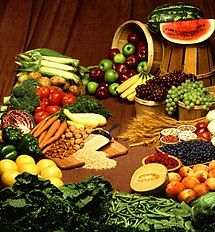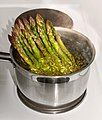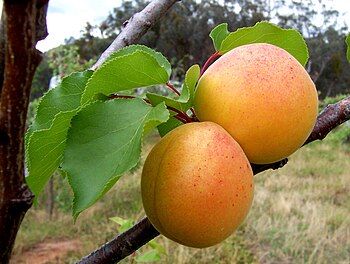Portal:Food
F o o d
A portal dedicated to food and foodways
Introduction


Food is any substance consumed by an organism for nutritional support. Food is usually of plant, animal, or fungal origin and contains essential nutrients such as carbohydrates, fats, proteins, vitamins, or minerals. The substance is ingested by an organism and assimilated by the organism's cells to provide energy, maintain life, or stimulate growth. Different species of animals have different feeding behaviours that satisfy the needs of their metabolisms and have evolved to fill a specific ecological niche within specific geographical contexts.
Omnivorous humans are highly adaptable and have adapted to obtain food in many different ecosystems. Humans generally use cooking to prepare food for consumption. The majority of the food energy required is supplied by the industrial food industry, which produces food through intensive agriculture and distributes it through complex food processing and food distribution systems. This system of conventional agriculture relies heavily on fossil fuels, which means that the food and agricultural systems are one of the major contributors to climate change, accounting for as much as 37% of total greenhouse gas emissions. (Full article...)
Cooking, also known as cookery or professionally as the culinary arts, is the art, science and craft of using heat to make food more palatable, digestible, nutritious, or safe. Cooking techniques and ingredients vary widely, from grilling food over an open fire, to using electric stoves, to baking in various types of ovens, reflecting local conditions. Cooking is an aspect of all human societies and a cultural universal.
Preparing food with heat or fire is an activity unique to humans. Archeological evidence of cooking fires from at least 300,000 years ago exists, but some estimate that humans started cooking up to 2 million years ago.
The expansion of agriculture, commerce, trade, and transportation between civilizations in different regions offered cooks many new ingredients. New inventions and technologies, such as the invention of pottery for holding and boiling of water, expanded cooking techniques. Some modern cooks apply advanced scientific techniques to food preparation to further enhance the flavor of the dish served. (Full article...)

KFC (also commonly referred to by its historical name Kentucky Fried Chicken) was founded by Colonel Harland Sanders, an entrepreneur who began selling fried chicken from his roadside restaurant in Corbin, Kentucky, during the Great Depression. Sanders identified the potential of restaurant franchising, and the first "Kentucky Fried Chicken" franchise opened in Salt Lake City, Utah, in 1952. KFC popularized chicken in the fast-food industry, diversifying the market by challenging the established dominance of the hamburger. Branding himself "Colonel Sanders", the founder became a prominent figure of American cultural history, and his image remains widely used in KFC advertising. The company's rapid expansion made it too large for Sanders to manage, so in 1964 he sold the company to a group of investors led by John Y. Brown Jr. and Jack C. Massey.
KFC was one of the first fast-food chains to expand internationally, opening outlets in Britain, Mexico, and Jamaica by the mid-1960s. Throughout the 1970s and 80s, KFC experienced mixed success domestically, as it went through a series of changes in corporate ownership with little or no experience in the restaurant business. In the early 1970s, KFC was sold to the spirits distributor Heublein, which was taken over by the R. J. Reynolds food and tobacco conglomerate, which later sold the chain to PepsiCo. The chain continued to expand overseas, and in 1987 KFC became the first Western restaurant chain to open in China. (Full article...)
Selected article –

Tea is an umbrella term for several different meals consisting of food accompanied by tea to drink. The English writer Isabella Beeton, whose books on home economics were widely read in the 19th century, describes meals of various kinds and provides menus for the "old-fashioned tea", the "at-home tea", the "family tea", and the "high tea".
Teatime is the time at which this meal is usually eaten, which is mid-afternoon to early evening. Tea as a meal is associated with the United Kingdom and some Commonwealth countries. Some people in Britain and Australasia refer to their main evening meal as "tea" rather than "dinner" or "supper", the use of "tea" differs based on social class, "tea" can refer to a light meal or a snack. A tea break is the term used for a work break in either the morning or afternoon for a cup of tea or other beverage. (Full article...)
Selected cuisine -

Lao cuisine or Laotian cuisine (Lao: ອາຫານລາວ, pronounced [ʔàː.hǎːn láːw], RTGS: ahan lao) is the national cuisine of Laos.
The staple food of the Lao is sticky rice (Lao: ເຂົ້າໜຽວ, khao niao, [kʰȁw nǐaw]). Laos has the highest sticky rice consumption per-capita in the world with an average of 171 kilograms (377 lb) of sticky rice consumed annually per person. Sticky rice is deeply ingrained in the culture, religious tradition, and national identity of Laos. It is a common belief within the Lao community that no matter where they are in the world, sticky rice will always be the glue that holds the Lao communities together, connecting them to their culture and to Laos. Affinity for sticky rice is considered the essence of what it means to be Lao. Often the Lao will refer to themselves as luk khao niao (Lao: ລູກເຂົ້າໜຽວ, [lùːk kʰȁw nǐaw]), which can be translated as 'children or descendants of sticky rice'. (Full article...)
Selected ingredient –
Worcestershire sauce or Worcester sauce (UK: /ˈwʊstər(ʃər)/ WUUST-ər(-shər)) is a fermented liquid condiment invented by pharmacists John Wheeley Lea and William Henry Perrins in the city of Worcester in Worcestershire, England, during the first half of the 19th century. The inventors went on to form the company Lea & Perrins.
Worcestershire sauce has been a generic term since 1876, when the English High Court of Justice ruled that Lea & Perrins did not own a trademark for the name "Worcestershire". (Full article...)
Selected recipe –
Brownies are typically eaten by hand or with utensils, and may be accompanied by a glass of milk, served warm with ice cream (à la mode), topped with whipped cream, or sprinkled with powdered sugar. In North America, they are common homemade treats and they are also popular in restaurants, ice cream parlors, and coffeehouses. (Full article...)
Pictured are Oatmeal Stout Brownies. This recipe, created by Joe Stutler, was a national finalist in the 2006 Cooking With Beer Challenge. The malt and oats in the beer enhance the flavor of the chocolate in these delicious brownies. Not overly cake-ey, not overly fudge-ey, the texture is nicely balanced. They're also decadently chocolate, and surprisingly light (thanks to the eggs). Great with a fruity beer, such as a lambic (Framboise, yum!).
New Paltz station is a former train station in the village of New Paltz in Ulster County, New York. The building was the first of two railroad stations constructed in the town of New Paltz, and it is the only former Wallkill Valley Railroad station standing at its original location.
After a lengthy public debate over whether to place the station to the east or west of the Wallkill River, it was built in 1870 on the east bank, within the village of New Paltz. The rail line was formally opened during a large ceremony on December 20, 1870. A decade later the station had become a popular departure point for the Mohonk Mountain House by many vacationers, including two U.S. presidents. In the late 19th century, over a dozen stagecoaches ran between the station and Mohonk daily. (Full article...)
Selected image –
Selected biography –
B. July 30, 1962
Alton Crawford Brown Jr. (born July 30, 1962) is an American television personality, food show presenter, food scientist, author, voice actor, and cinematographer. He is the creator and host of the Food Network television show Good Eats that ran for 16 seasons, host of the miniseries Feasting on Asphalt and Feasting on Waves, and host and main commentator on Iron Chef America and Cutthroat Kitchen. Brown is a best-selling author of several books on food and cooking. A recap series titled Good Eats Reloaded aired on Cooking Channel, and a true sequel series, Good Eats: The Return, ran from 2019 to 2021 on Food Network. (Full article...)
Did you know (auto-generated) –

- ... that exercises in the fair division of food are often used to teach unit fractions?
- ... that when Mexia Supermarket was abandoned because of its owners' bankruptcy, all of the food inside was left to rot for more than three months?
- ... that some fans of Genshin Impact have referred to the character Paimon as "emergency food"?
- ... that food YouTuber Mike Chen also runs a channel documenting strange phenomena?
- ... that Mitch Torres is a "self-proclaimed damper destroyer"?
- ... that Binggrae, a South Korean food and beverage company, was the official ice cream supplier of the 1988 Seoul Olympics?
More did you know –
Related portals
Food topics
The following are topics relating to food
Categories
Food list articles
- See also: Lists of foods and Category:Lists of drinks
The following are some Food list articles on Wikipedia:

- American cheeses
- Appellation d'Origine Contrôlée cheeses
- Apple cultivars
- Bacon dishes
- Bacon substitutes
- Basil cultivars
- Breads
- Breakfast beverages
- Breakfast cereals
- Breakfast foods
- British cheeses
- Cakes
- Candies
- Cheeses
- Cheese soups
- Christmas dishes (list)
- Cocktails
- Cookies
- Dishes using coconut milk
- Diets
- Doughnut varieties
- Egg dishes
- Fermented soy products
- Food additives
- Food additives (Codex Alimentarius)
- Foods named after people
- French cheeses
- French dishes
- Fried dough foods
- Fruits
- List of hamburgers
- Herbs and spices
- Hors d'oeuvre
- Indian dishes
- Indian snack foods
- Indonesian dishes
- Italian dishes
- Japanese snacks
- Japanese dishes
- Jewish dishes
- Kebabs
- Korean beverages
- Mango cultivars
- Moroccan dishes
- Pasta
- Pastries
- Philippine snack food
- Pies, tarts and flans
- Poppy seed pastries and dishes
- Potato dishes
- Puddings
- Raw fish dishes
- Rice dishes
- Rolled foods
- Sauces
- Seafood
- Seeds
- Sandwiches
- Snack foods
- Soft drinks by country
- Soul foods and dishes
- Soups
- Stews
- Street foods
- Tapas
- Turkish dishes
- Twice-baked foods
- Vegetable oils
- Vegetables
- Vodkas
Things you can do
Related WikiProjects
| Parent project: WikiProject Food and Drink | |
| Child projects: | Task forces: (All inactive) |
|
|
| Related projects: | |
New articles
Rules | Match log | Results page (for watching) | Last updated: 2024-11-28 19:19 (UTC)
Note: The list display can now be customized by each user. See List display personalization for details.
- Daejeon Munhwa Broadcasting Corporation (edit | talk | history | links | watch | logs | tools) by RandomMe98 (talk · contribs · new pages (38)) started on 2024-11-28, score: 10
- Metapenaeopsis mogiensis (edit | talk | history | links | watch | logs | tools) by Sevenstxrsquid (talk · contribs · new pages (11)) started on 2024-11-28, score: 10
- Raw Farm (edit | talk | history | links | watch | logs | tools) by Atubofsilverware (talk · contribs · new pages (5)) started on 2024-11-27, score: 10
- Corone (bread) (edit | talk | history | links | watch | logs | tools) by Momiji-Penguin (talk · contribs · new pages (5)) started on 2024-11-27, score: 30
- Kumpir (edit | talk | history | links | watch | logs | tools) by By caner28 (talk · contribs · new pages (4)) started on 2024-11-27, score: 30
- Stiegl Brewery (edit | talk | history | links | watch | logs | tools) by Gray eyes (talk · contribs · new pages (176)) started on 2024-11-27, score: 10
- Creamed spinach (edit | talk | history | links | watch | logs | tools) by A75 (talk · contribs · new pages (5)) started on 2024-11-26, score: 10
- Zubr Brewery (edit | talk | history | links | watch | logs | tools) by Gray eyes (talk · contribs · new pages (176)) started on 2024-11-26, score: 10
- Ipomoea muelleri (edit | talk | history | links | watch | logs | tools) by MargaretRDonald (talk · contribs · new pages (4)) started on 2024-11-26, score: 10
- Atalaya brevialata (edit | talk | history | links | watch | logs | tools) by MargaretRDonald (talk · contribs · new pages (4)) started on 2024-11-25, score: 10
- Riposte Alimentaire (edit | talk | history | links | watch | logs | tools) by Thriley (talk · contribs · new pages (105)) started on 2024-11-25, score: 10
- Bankeir, British Columbia (edit | talk | history | links | watch | logs | tools) by DMBanks1 (talk · contribs · new pages (1)) started on 2024-11-25, score: 10
- Bansh (edit | talk | history | links | watch | logs | tools) by LittleT889 (talk · contribs · new pages (2)) started on 2024-11-25, score: 10
- Medallion (food) (edit | talk | history | links | watch | logs | tools) by Noble Attempt (talk · contribs · new pages (20)) started on 2024-11-25, score: 10
- Wei Tchou (edit | talk | history | links | watch | logs | tools) by Phibeatrice (talk · contribs · new pages (141)) started on 2024-11-24, score: 10
- Milco (edit | talk | history | links | watch | logs | tools) by Abishe (talk · contribs · new pages (69)) started on 2024-11-24, score: 20
- Lily O'Brien's (edit | talk | history | links | watch | logs | tools) by Newbydge (talk · contribs · new pages (6)) started on 2024-11-23, score: 10
- The Protein Works (edit | talk | history | links | watch | logs | tools) by Taylordanrw (talk · contribs · new pages (1)) started on 2024-11-22, score: 20
- Give Me a Band and a Bandana (edit | talk | history | links | watch | logs | tools) by Rn.brito (talk · contribs · new pages (4)) started on 2024-11-23, score: 10
- Vaillant's smooth-head (edit | talk | history | links | watch | logs | tools) by Quetzal1964 (talk · contribs · new pages (103)) started on 2024-11-23, score: 10
- Ya dong (edit | talk | history | links | watch | logs | tools) by Paul 012 (talk · contribs · new pages (13)) started on 2024-11-23, score: 10
- Suan la fen (edit | talk | history | links | watch | logs | tools) by 8UB3RG1N3 (talk · contribs · new pages (3)) started on 2024-11-23, score: 10
- Kuanfen noodles (edit | talk | history | links | watch | logs | tools) by 8UB3RG1N3 (talk · contribs · new pages (3)) started on 2024-11-22, score: 10
- 8424 watermelon (edit | talk | history | links | watch | logs | tools) by CanonNi (talk · contribs · new pages (20)) started on 2024-11-22, score: 10
- Chloronitramide anion (edit | talk | history | links | watch | logs | tools) by Mrfoogles (talk · contribs · new pages (10)) started on 2024-11-21, score: 10
- Candia (brand) (edit | talk | history | links | watch | logs | tools) by Leeanah (talk · contribs · new pages (15)) started on 2024-11-21, score: 10
- The Return of Don Quixote (edit | talk | history | links | watch | logs | tools) by Justinkrivers (talk · contribs · new pages (3)) started on 2024-11-21, score: 10
- Portland Cider Company (edit | talk | history | links | watch | logs | tools) by Another Believer (talk · contribs · new pages (46)) started on 2024-11-20, score: 10
- Four Faultless Felons (edit | talk | history | links | watch | logs | tools) by Justinkrivers (talk · contribs · new pages (3)) started on 2024-11-17, score: 10
- 290 (disambiguation) (edit | talk | history | links | watch | logs | tools) by 88.235.214.122 (talk · contribs · new pages (0)) started on 2024-11-12, score: 20
- 287 (disambiguation) (edit | talk | history | links | watch | logs | tools) by 88.235.214.122 (talk · contribs · new pages (0)) started on 2024-11-12, score: 20
- D82 (edit | talk | history | links | watch | logs | tools) by 88.235.214.122 (talk · contribs · new pages (0)) started on 2024-11-12, score: 20
- 901 (disambiguation) (edit | talk | history | links | watch | logs | tools) by 88.235.214.122 (talk · contribs · new pages (0)) started on 2024-11-12, score: 20
- Ian Macleod Distillers (edit | talk | history | links | watch | logs | tools) by Angryskies (talk · contribs · new pages (2)) started on 2024-11-20, score: 10
- Tibet Development Company (edit | talk | history | links | watch | logs | tools) by TinaLees-Jones (talk · contribs · new pages (79)) started on 2024-11-20, score: 20
- Jam Jams (edit | talk | history | links | watch | logs | tools) by 74.3.135.94 (talk · contribs · new pages (3)) started on 2024-11-18, score: 20
- David R. Chan (edit | talk | history | links | watch | logs | tools) by Mikeblas (talk · contribs · new pages (4)) started on 2024-11-18, score: 10
- Murad Al-Katib (edit | talk | history | links | watch | logs | tools) by Mary Mark Ockerbloom (talk · contribs · new pages (8)) started on 2024-11-16, score: 10
- Sofi Malt SE (edit | talk | history | links | watch | logs | tools) by AsteriodX (talk · contribs · new pages (19)) started on 2024-11-17, score: 10
- Clinking glasses (edit | talk | history | links | watch | logs | tools) by Викидим (talk · contribs · new pages (7)) started on 2024-11-16, score: 10
- Look at This Blue (edit | talk | history | links | watch | logs | tools) by Phibeatrice (talk · contribs · new pages (141)) started on 2024-11-15, score: 10
- Kosher slaughterer (edit | talk | history | links | watch | logs | tools) by Boxes12 (talk · contribs · new pages (7)) started on 2024-11-15, score: 10
- Pflaumentoffel (edit | talk | history | links | watch | logs | tools) by Thriley (talk · contribs · new pages (105)) started on 2024-11-15, score: 10
- CTV Specialty Television (edit | talk | history | links | watch | logs | tools) by 76.67.94.153 (talk · contribs · new pages (1)) started on 2024-11-15, score: 10
- Dry fruits (edit | talk | history | links | watch | logs | tools) by WikieMouse (talk · contribs · new pages (1)) started on 2024-11-15, score: 20
- Mahura flower (edit | talk | history | links | watch | logs | tools) by Ameliahill08 (talk · contribs · new pages (2)) started on 2024-11-14, score: 10
- Nuts.com (edit | talk | history | links | watch | logs | tools) by Thriley (talk · contribs · new pages (105)) started on 2024-11-14, score: 20
- Alexei Zimin (edit | talk | history | links | watch | logs | tools) by No Swan So Fine (talk · contribs · new pages (6)) started on 2024-11-14, score: 10
Associated Wikimedia
The following Wikimedia Foundation sister projects provide more on this subject:
-
Commons
Free media repository -
Wikibooks
Free textbooks and manuals -
Wikidata
Free knowledge base -
Wikinews
Free-content news -
Wikiquote
Collection of quotations -
Wikisource
Free-content library -
Wikiversity
Free learning tools -
Wiktionary
Dictionary and thesaurus
















































